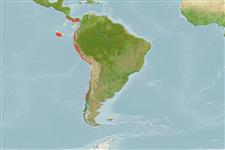Environment: milieu / climate zone / depth range / distribution range
Ecology
Marine; demersal; depth range 0 - 700 m (Ref. 106604). Subtropical; 10°N - 40°S, 95°W - 70°W (Ref. 114953)
Eastern Pacific: From Costa Rica to Chile, and Galapagos Is. (Ref. 130539).
Size / Weight / Age
Maturity: Lm ? range ? - ? cm
Max length : 90.0 cm TL male/unsexed; (Ref. 114953)
Lives on the continental shelf, usually in very shallow waters. Feeds on invertebrates and benthic fishes. Ovoviviparous (Ref. 50449). Maturity size of males usually at ca. 40 cm TL (Ref. 114953). The electric organs can produce a discharge of about 45 volts, depending on the size of the animal. The discharge is used to stun prey and as defense against predators.
Life cycle and mating behavior
Maturity | Reproduction | Spawning | Eggs | Fecundity | Larvae
Exhibit ovoviparity (aplacental viviparity), with embryos feeding initially on yolk, then receiving additional nourishment from the mother by indirect absorption of uterine fluid enriched with mucus, fat or protein through specialised structures (Ref. 50449).
McEachran, J.D., 1995. Torpedinidae. Tembladeras, tremolinas. p. 784-785. In W. Fischer, F. Krupp, W. Schneider, C. Sommer, K.E. Carpenter and V. Niem (eds.) Guia FAO para Identification de Especies para lo Fines de la Pesca. Pacifico Centro-Oriental. 3 Vols. FAO, Rome. (Ref. 9264)
IUCN Red List Status (Ref. 130435: Version 2024-1)
Human uses
Fisheries: of no interest
Tools
Special reports
Download XML
Internet sources
Estimates based on models
Phylogenetic diversity index (Ref.
82804): PD
50 = 0.5001 [Uniqueness, from 0.5 = low to 2.0 = high].
Bayesian length-weight: a=0.01479 (0.00665 - 0.03288), b=2.96 (2.77 - 3.15), in cm total length, based on LWR estimates for this (Sub)family-body shape (Ref.
93245).
Trophic level (Ref.
69278): 4.0 ±0.61 se; based on food items.
Resilience (Ref.
120179): Very Low, minimum population doubling time more than 14 years (Preliminary K or Fecundity.).
Fishing Vulnerability (Ref.
59153): High vulnerability (56 of 100).
Nutrients (Ref.
124155): Calcium = 18.8 [3.8, 89.1] mg/100g; Iron = 0.691 [0.177, 2.037] mg/100g; Protein = 18.3 [13.9, 21.7] %; Omega3 = 0.428 [0.181, 0.942] g/100g; Selenium = 28.9 [9.4, 83.9] μg/100g; VitaminA = 11 [4, 34] μg/100g; Zinc = 0.562 [0.275, 1.039] mg/100g (wet weight);
